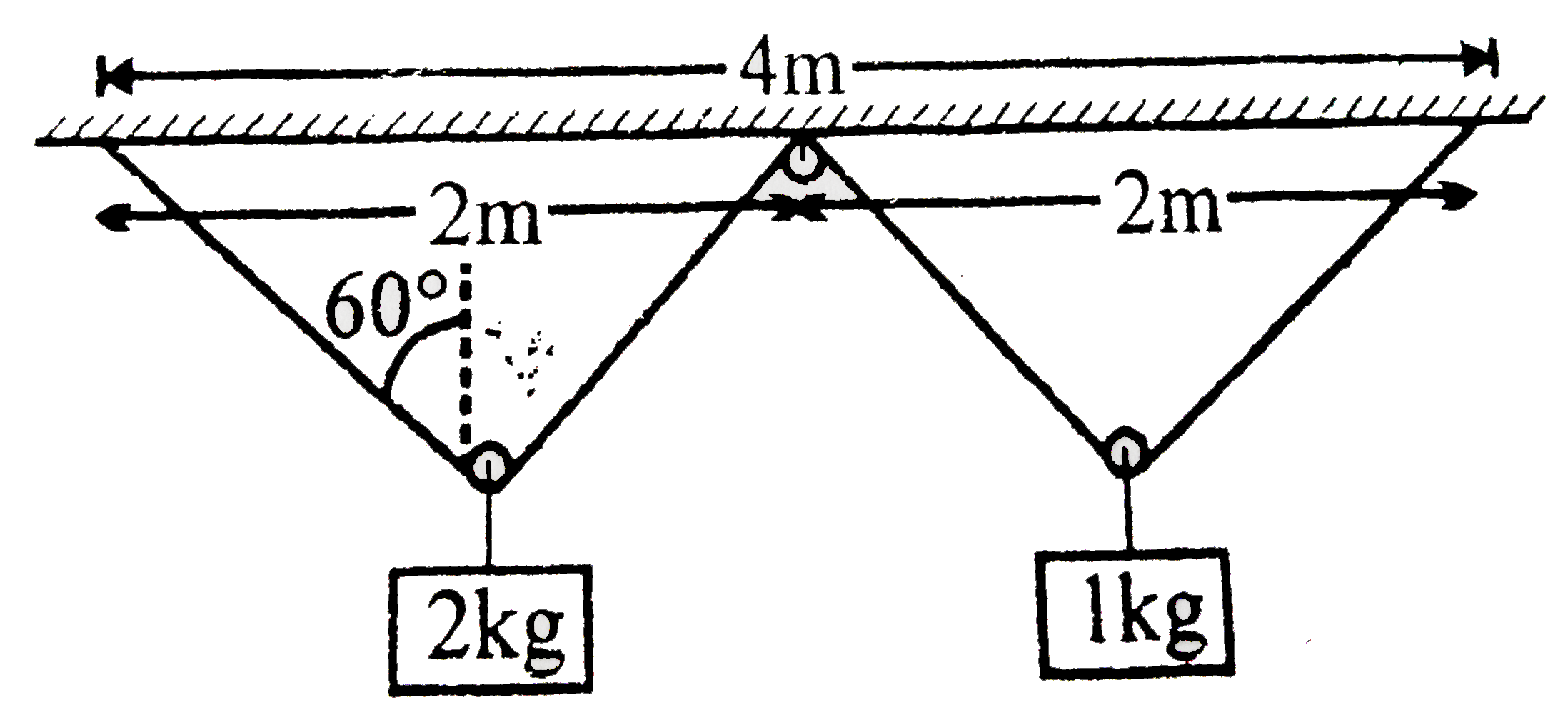In figure shown, pulleys are ideal m1>2m2. Initially the system is in equilibrium and string connecting m2 to rigid support below is cut. Find the initial acceleration of m2 ?

The correct Answer is:(m1−2m22m2)g
Step by step video & image solution for In figure shown, pulleys are ideal m_(1)gt 2m_(2). Initially the system is in equilibrium and string connecting m_(2) to rigid support below is cut. Find the initial acceleration of m_(2) ? by Physics experts to help you in doubts & scoring excellent marks in Class 12 exams.
Updated on:21/07/2023Topper's Solved these Questions
- NLM & FRICTIONBOOK - MOTIONCHAPTER - NLM & FRICTIONEXERCISE - EXERCISE-4 ( LEVEL-I)
13 Videos
- NLM & FRICTIONBOOK - MOTIONCHAPTER - NLM & FRICTIONEXERCISE - EXERCISE-4 ( LEVEL-II)
15 Videos
- NLM & FRICTIONBOOK - MOTIONCHAPTER - NLM & FRICTIONEXERCISE - EXERCISE-3(Level-I)
18 Videos
- NEWTON'S LAWS OF MOTION & FRICTION BOOK - MOTIONCHAPTER - NEWTON'S LAWS OF MOTION & FRICTION EXERCISE - Exercise - 3 Section-B
12 Videos
- ONE DIMENSION MOTIONBOOK - MOTIONCHAPTER - ONE DIMENSION MOTIONEXERCISE - Exercise - 3 |Section - B Previous Year Problems | JEE MAIN
12 Videos
Similar Questions
In figure shown, pulley are ideal m1>2m2. Initially the system is in equilibrium and string connecting m2 to rigid support below is cut. Find the initial acceleration of m2 If m1=6kg,m2=2.5kg and g=10ms−2

View SolutionIn the figure shown, pulley and spring are ideal and strings are lilght and inextensible. Intially all the bodies are at rest when string connecting A and B is cut. Find initial acceleration of C.

View Solution
Knowledge Check
For the system shown in fog. m1>m2>m3>m4. Initially, the system is at rest in equilibrium condition., if the string joining m4 and ground is cut, then just after the string is cut.

Statement I: m1,m2,m3 remain stationary.
Statement II: The value of acceleration of all the four blocks can be determined.
Statement III: Only m4 remain stationary.
Statement IV: Only m4 accelerates.AAll the statement are correct.BOnly I, II and IV are correct.COnly I,and II are correct.DOnly II and IV are correct.Initially the system shown in figure is in equilibrium. At the moment, the string is cut the downward of a(1) and a2 are.
 .A(a) zero and zeroB(b) 2g and zeroC(c) g and zeroD(d) None of the above
.A(a) zero and zeroB(b) 2g and zeroC(c) g and zeroD(d) None of the aboveIn the figure shown all pulleys are ideal and small. The central pulleys is 2 m away from both ends. What is the length (in m) of the string ? The system is in equilibrium
 A8√3B4√4[1+2√5]C4√3[1+2√3]D2√3+4
A8√3B4√4[1+2√5]C4√3[1+2√3]D2√3+4
Find m3 if the system is in equilibrium the incline is smooth and string and pulley are light

View SolutionConsider the system of masses and pulleys shown in fig. with massless string and fricitionless pulleys.
(a) Give the necessary relation between masses m1 and m2 such that system is in equilibrium and does not move.
(b) If m1=6kg and m2=8kg, calculate the magnitude and direction of the acceleration of m1.

View SolutionA mass m1 lies on fixed, smooth cylinder . An ideal cord attached to m1 passes over the cylinder and is connected to mass m2 as shown in the figure.
(a) Find the value of θ( shown in diagram ) for which the system is in equilibrium.
(b) Given m1=5kg,m2=4kg . The system is released from rest when θ=30∘ . Find the magnitude of acceleration of mass m1 just after the system is released.

View SolutionSimple Atwood Machine as System of Particles
The system shown in the figure is known as simple Atwood machine. Initially the masses are held at rest and then let free. Assuming mass m2 more than the mass m1, find acceleration of mass center and tension in the string supporting the pulley.

View SolutionMasses m1,m2,m3 and m4 are arranged in a system as shown in fig where m1+m2>m3+m4 The lower string keeping the system in equilibrium is burnt The masses start moving. Find the acceleration of masses if the threads are weightless and inextensible the springs are also weightless and the mass of the pulley is negligible.

View Solution
